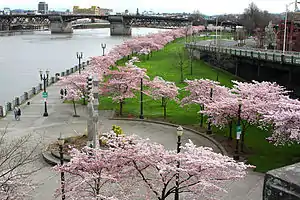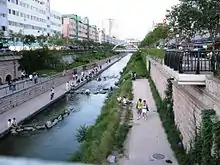Freeway removal
Freeway removal is a public policy of urban planning policy to demolish freeways and create mixed-use urban areas, parks, residential, commercial, or other land uses. Such highway removal is often part of a policy to promote smart growth, transit-oriented development, walkable and bicycle-friendly cities. In some cases freeways are re-imagined as boulevards, rebuilt as tunneled freeways (see tunnels) or relocated through less densely-developed areas.

Urban design
Urban freeways were built to expedite traffic into and out of cities in the mid 20th century. Many of these freeways were built through dense neighborhoods, and destroyed blocks and sometimes entire neighborhoods in the process.[1] In some cities, strategies were implemented or planned for freeway removal policies to tear down highways that cut through neighborhoods. These freeways created blight that minimized use of land space and reduced the quality of life for city residents. The alternative that some cities have chosen for urban design is to replace elevated highways with boulevards to restore neighborhoods affected by highway construction.[2] In some regions, freeway removal has been proposed but these plans have not yet been completed or funded. In many cases, there are political battles between citizens' groups who are proponents of freeway removal proposals and drivers that want to keep the freeways.[3]
To increase land usage, the demolition of freeways is often a part of the discussion for both city and state's governmental strategies. Cities planning redevelopment of certain neighborhoods, such as Washington, D.C.’s Whitehurst Freeway in the neighborhood of Georgetown, were set for demolition but were frozen so the city may do an environmental impact study. Other cities – such as Nashville, Tennessee, whose government is planning to demolish the downtown loop where three major interstates (I-65, I-40, and I-24) converge – are planning to replace these areas with parks, boulevards, and mixed-use communities that will reconnect their cores with adjacent neighborhoods.[3]
Urban intensification

To counteract urban sprawl, some cities have made redevelopment plans around urban intensification. Urban intensification – also known as Compact Cities in Europe – is an urban planning technique which promotes high residential density with mixed land uses based around an efficient public transport system. Typically, cities redevelop neighborhoods to concentrate growth in the center of the city with the goal of better land usage to support a high concentration of jobs and residents. Smart growth principles and incentives generate residential, retail, and recreational development. The purpose is to transform deteriorating, low-density commercial corridors into mixed-use corridors that focus around transit-oriented development. Cities have implemented plans to use intensification corridors functioning as boulevards aimed at being transit supportive and pedestrian friendly, and provide\ a focus for higher density mixed-use development.[4]
The success of transit oriented development along these corridors with subsequent increase in transit ridership has been well documented in neighborhoods such as Ballston and Rosslyn in Arlington County, Virginia.[5] Other cities, such as Portland Oregon, have implemented freeway removal policies to create intensification corridors. Much of this began in the freeway and expressway revolts of the 1960s and 1970s.
Boulevards and urban design
Portland, Oregon and Milwaukee, Wisconsin executed freeway removal projects that reduced traffic, spurred economic development, and allowed for the creation of new neighborhoods and commercial districts. The Harbor Drive Freeway in Portland was replaced by Tom McCall Waterfront Park, while the Park East Freeway in Milwaukee recovered prime land for development in the urban core. In Toronto, Ontario, the easternmost portion of the Gardiner Expressway, which was located between Don Road and Leslie Street, was demolished in 2000 and replaced with an at-grade urban boulevard with traffic lights, railroad crossings and a bike trail.
After acute damage to San Francisco's double-decked Embarcadero Freeway and Central Freeway occurred during the Loma Prieta earthquake in 1989, they were demolished, but only after several years' wait. [6] The Central Freeway was replaced by the multi-modal, landscaped surface-level Octavia Boulevard, and the Embarcadero Freeway was replaced by a boulevard with streetcar and light rail operations in the median, flanked by the restored Beaux-Arts style Ferry Building.[7]
Underground relocation
In some situations where removing an urban freeway would exacerbate traffic problems within a city, urban planners may resort to constructing tunnels to relocate the freeway underground and reclaim the surface space previously occupied by the facility.
In Boston, Massachusetts, the Central Artery (Interstate 93) ran through the center of the city on an elevated green viaduct from its opening in the 1950s until 2005. The freeway divided historic neighborhoods and business districts in downtown Boston, and it was referred to as Boston's "other Green Monster." During the 1990s and early 2000s, a $15 billion project known as the Big Dig relocated the Central Artery into tunnels underneath downtown Boston; the old viaduct was demolished, and its path was reclaimed for a surface boulevard and park space.
The Alaskan Way Viaduct in Seattle, Washington, was replaced with the a tunnel that carries the SR-99 freeway underneath the city.
Projects
Completed projects include:
- Alaskan Way Viaduct in Seattle, Washington (Replaced by tunnel)
- Central Artery in Boston, Massachusetts (relocated underground)
- Central Freeway and Embarcadero Freeway in San Francisco, California
- Cheonggye Elevated Highway in Seoul, South Korea
- Gardiner Expressway in Toronto, Ontario (stub east of downtown)
- Harbor Drive in Portland, Oregon
- Inner Loop in Rochester, New York (closed in December 2014)
- Interstate 30 in Fort Worth, Texas (relocated)
- Interstate 170 in Baltimore, Maryland (western stub removed for expansion of the West Baltimore station's parking lot and possible Red Line project)
- Interstate 195 in Providence, Rhode Island (relocated as part of the Iway project)
- Oklahoma City Crosstown Expressway in Oklahoma City, Oklahoma (relocated)
- Park East Freeway in Milwaukee, Wisconsin
- Robert Moses State Parkway in Niagara Falls, New York
- Southeast Freeway in Washington, D.C. (easternmost portion)
- Voie Georges-Pompidou in Paris, France
- West Sacramento Freeway in Sacramento, California (except westernmost portion)
- West Side Elevated Highway in New York City, New York (except northernmost portion)
- Zhongxiao Elevated Highway in Taipei, Taiwan
Many other cities have plans or are discussing the removal of freeways in their policies for redevelopment such as:
- Bonaventure Expressway in Montreal, Quebec (under construction)
- Claiborne Expressway in New Orleans, Louisiana[8]
- Cleveland Memorial Shoreway in Cleveland, Ohio
- Cogswell Interchange in Halifax Regional Municipality
- Downtown Connector in Atlanta, Georgia (proposed to be rerouted into tunnels beneath the city)[9]
- Innerbelt in Akron, Ohio
- Interstate 70 through downtown Denver, Colorado (proposed to be rerouted into tunnels beneath the city)
- Interstate 345 in Dallas, Texas[10]
- Interstate 375 in Detroit, Michigan[11]
- Metropolitan Expressway in Tokyo, Japan[3]
- NY 895 (Sheridan Expressway) in New York City, New York (under construction)[12]
- Oak Street Connector in New Haven, Connecticut (under construction)
- Route 79 in Fall River, Massachusetts (under construction)
- U.S. 101 in Downtown Los Angeles, California (proposed to be rerouted into tunnels underneath a new park)
- Whitehurst Freeway in Washington, D.C.
See also
References
- "60 Years of Urban Change: Midwest". The Institute for Quality Communities. 2014-12-12. Retrieved 2017-09-12.
- "Reconnecting Cities through Urban Highway Removals - Car Free America". Car Free America. 2017-09-11. Retrieved 2017-09-12.
- Staff (2007). "Freeway Removal Plans and Proposals". Preservation Institute. Retrieved November 22, 2010.
- Shih, Melissa (2009). Municipal Conformity to the Growth Plan for the Greater Golden Horseshoe: An Evaluation of Future Density Potential Along the Fairview Street Intensification Corridor in Burlington, Ontario. Kingston, ON: Queens University.
- Urban Form Case Studies. Ontario Ministry of Energy and Infrastructure. 2009.
- http://www.sfgate.com/news/article/Timeline-A-look-back-at-the-Embarcadero-2642356.php, accessed July 19, 2013
- http://streetswiki.wikispaces.com/Embarcadero+Freeway+Removal, accessed July 19, 2013
- http://www.nola.com/politics/index.ssf/2013/04/claiborne_avenue_study_looks_a_1.html, accessed July 19, 2013.
- http://www.bizjournals.com/atlanta/news/2015/04/07/georgia-dot-eyes-tunnel-double-deck-for-downtown.html
- http://artsblog.dallasnews.com/2014/02/highway-tear-out-proposal-not-dead.html/
- http://www.freep.com/article/20131124/BUSINESS06/311240072/I-375-downtown-MDOT
- Rivoli, Dan (September 19, 2018). "Feds pave way to transform the Bronx's Sheridan Expressway". nydailynews.com. Retrieved September 20, 2018.